This article was originally published in issue 12 of The Cross-Pollinator, July 2020.
A lightning strike on 26 October 2019 ignited a large fire at Gospers Mountain in the Wollemi National Park northwest of Sydney. As of 27 December 2019, it had burnt over 500,000 hectares making it the biggest forest fire in Australian history. The fire burnt places where I have looked for bees over the last 20 years and it caused me to reflect on what had been found there. Of the many sites that have suffered, two stand out, for different reasons. One, Putty Road, is memorable for the number and variety of bees found there and the other, Newnes Plateau, because it was home to a species of particular interest. The future of both sites is still unclear, but while there are glimpses of recovery, I don’t expect either to be quite the same again.
Putty Road Site
The first site, on the Putty Road northwest of Sydney, was a place of diverse flora that changed with the seasons. In October and November there were massed displays of Leptospermum and Callistemon, in February and March large stands of Persoonia oblongata. By April the area was covered with a knee-high carpet of Prickly Broom-heath (Monotoca scoparia) and Bossiaea heterophylla. In between there were scattered examples of many other flowers which provided opportunities for a wide range of bee species.
One of the reasons I remember it is that it was the only place close to Sydney where I saw the lovely species Trichocolletes sericeus, which is one of my favourites. It has a rather unusual distribution, having been found on Stradbroke Island, this site near Sydney and near the border between South Australia and Victoria. Have we not looked hard enough to know whether it occurs between these sites, or does it prefer a particular type of sandy soil in which to dig its nest?

All Trichocolletes are beautiful and because most of them prefer pea flowers they are often involved in the pollination of Donkey Orchids. In fact, I have often been unaware of the presence of orchids until alerted by bees carrying pollinia like tiny flags. Donkey Orchids, which offer no reward for bees, are thought to deceive native bees into visiting their flowers by mimicking food-rewarding native pea plants.
Another bee with an unusual distribution is a tiny euryglossine with a huge head. Euryglossina leyburnensis had been found in southern Queensland and in the southeastern corner of Victoria. Were these two separate populations or had the species just evaded detection? When the Leptospermum were in full bloom on the Putty Road, some of the clumps were surrounded by swarms of tiny bees and among them were a few examples of this curious species. It is so curious that it featured in an American book of spectacular bee photos (1), and that book went on to inspire James Dorey to produce his own Australian version(2).
For me, the importance of the find was that we now had evidence that E. leyburnensis is probably found right along the eastern seaboard, but not very common. Nor was it the only such bee, just the most spectacular. Three additional species, two with long heads, previously had the same distribution as E. leyburnensis and they, too, turned up at the Putty Road site.

While the October-November flowers attracted large numbers of tiny bees, the Persoonia of February-March attracted bees of medium and large size. The flowers of Persoonia make visitors to push into the gap between the style and the anthers, which requires some strength. Any visitor who succeeds in doing this will have brushed its body past all the pollen on the anther, increasing the chances that it will carry some away. A few bee species in the subgenus Leioproctus (Cladocerapis) have females with spines on their front legs that enable them to rake pollen from the anthers and use it to feed their larvae.
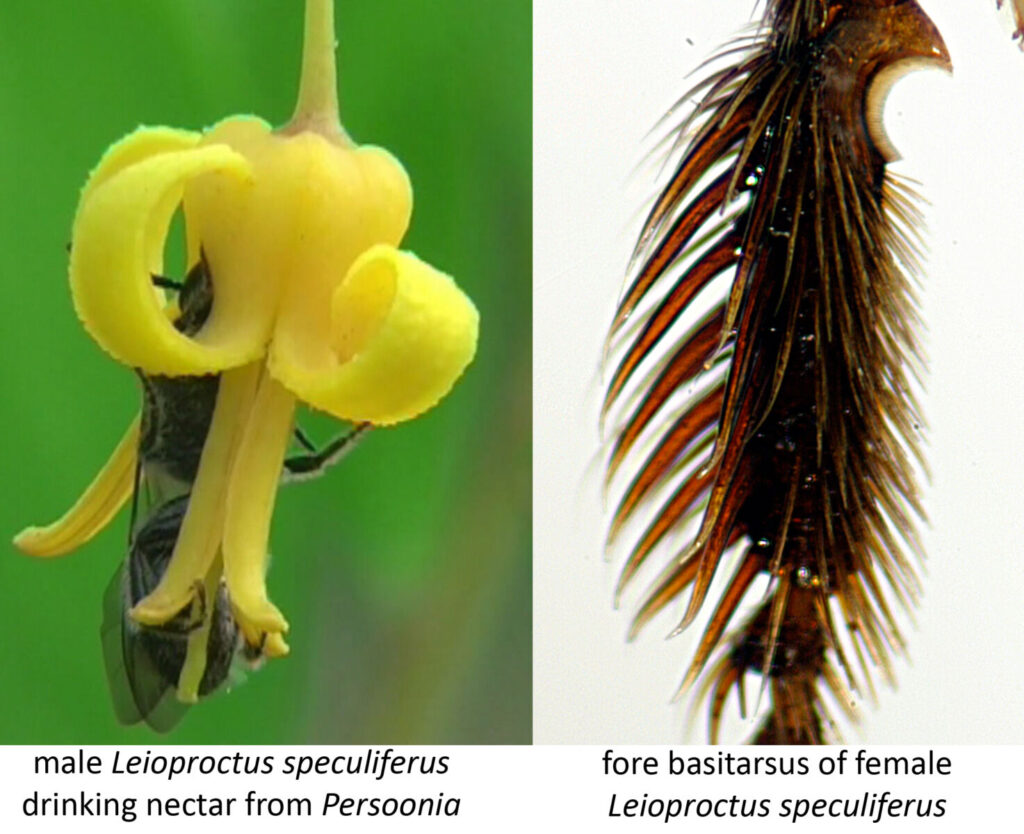
There are, however, a few very small bees that are also specialised visitors to Persoonia. Their problem is how to reach the nectar. Females can manage to lift the anthers just enough to rake out pollen but to get nectar they have to use the very narrow crack between the tepals at the base of the flower. The gap is too narrow for their tongue, but they have evolved a set of very long hairs on the end of the tongue which they insert into the crack and draw up nectar by capillary action. The Putty Road site is where I was able to film Leioproctus (Filiglossa) filamentosus performing this remarkable activity(3). Bees around the World have evolved many unusual adaptations for foraging, but this particular modification is unique.
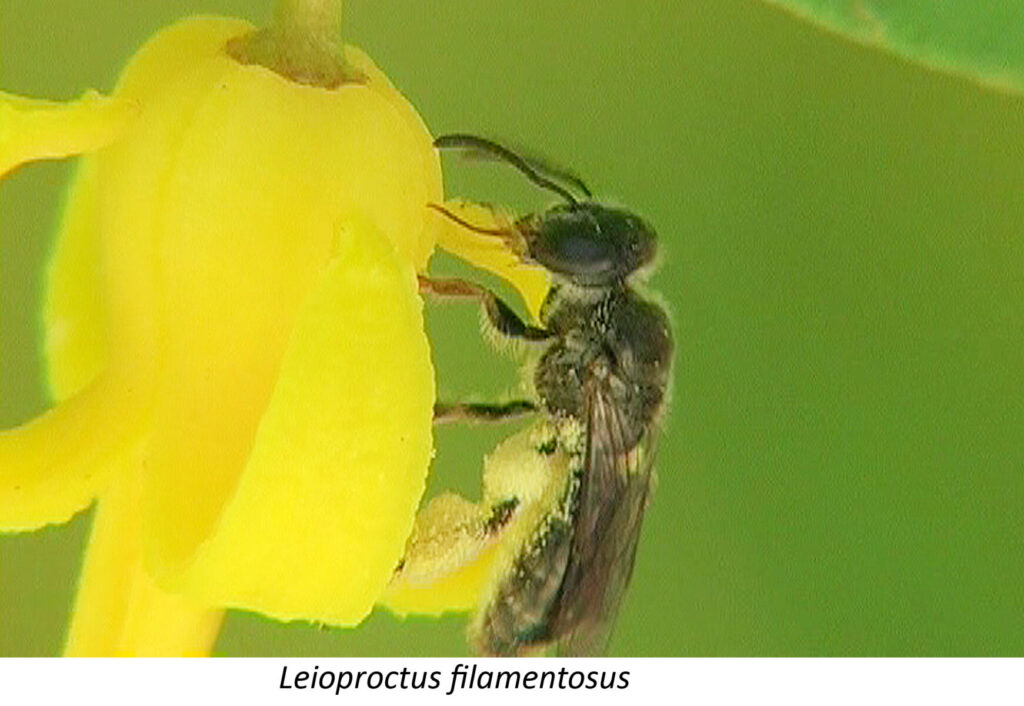
Although the behaviour of the specialist bees makes them very effective pollinators, the Persoonia are visited by many different bee species and are not, therefore, dependent on the specialists under normal conditions.
And there are many bees and flowers at the Putty Road site that we have not touched upon. So far I have found 127 bee species visiting flowers of 34 different plant species. At least seven of the bee species have not been named or reported previously. One is a second Leioproctus (Filiglossa) species that has, so far, been found only on a prostrate Persoonia that blooms in October and November before Persoonia oblongata flowers. The new species has been found at another location but on the same prostrate Persoonia.
The Putty Road site was burnt in the second week of November 2019, slightly less than three weeks after the start of the Gospers Mountain fire. Three months later I went to see how it had fared. The ground had green cover, but there was no sign of the Persoonias that should have been flowering. For safety reasons I was unable to explore away from the roadside, but all the Persoonia and Callistemon appeared to have been destroyed with no sign yet of regrowth. Only a few roadside weeds were flowering.
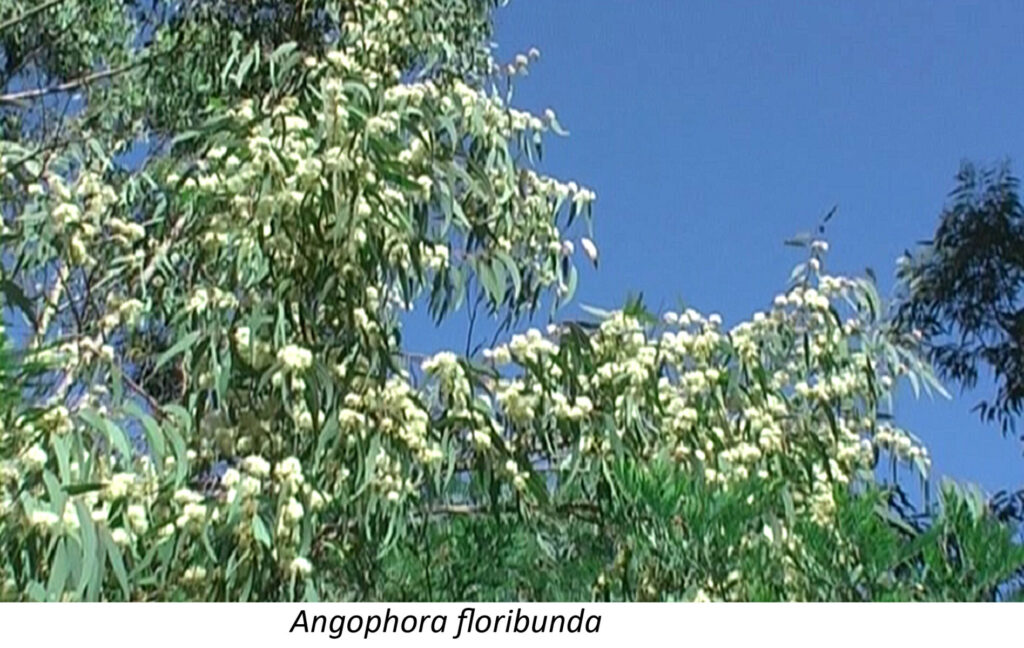
I turned back towards home, but before I had covered 2 km there was a small patch of white blossom beside the road which, on closer inspection, turned out to be a large Angophora floribunda surrounded by half-a-dozen teenagers about 5 m tall, all in full bloom.
What surprised me was that the air was filled with a loud hum, like the one produced by feral European Honeybees when they find a flowering eucalypt, except that I did not see any European Honeybees. The sound was from Paracolletes crassipes.
Where they came from, how far they had travelled, whether they were able to provision nests for the next generation I have no idea, but it was heartening to see that the fire had left at least one refugium and a significant population of bees.
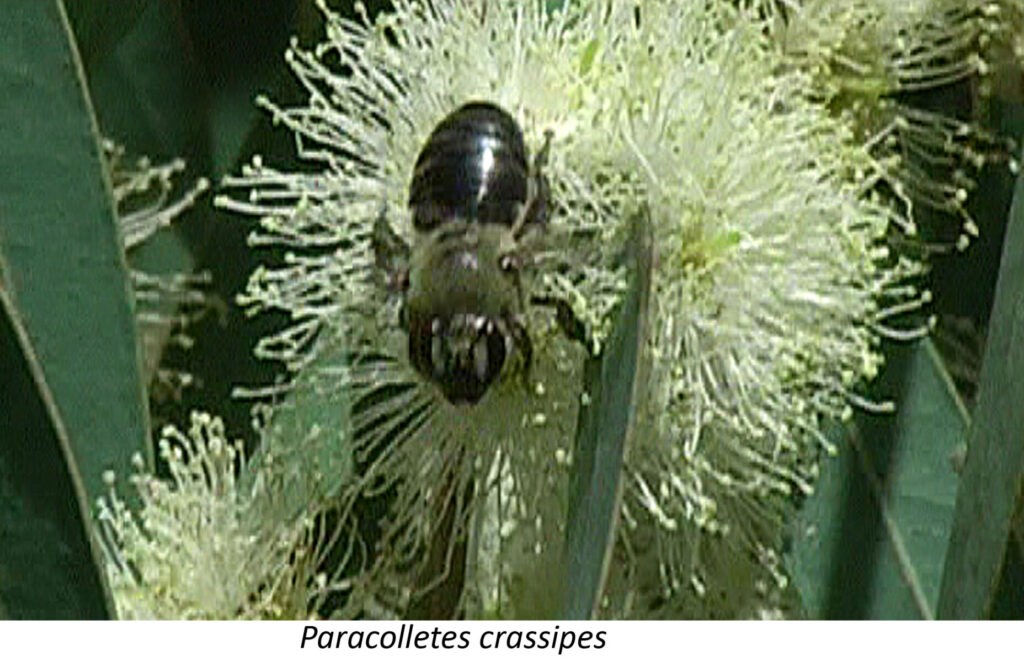
Although not brightly coloured, it is a large bee and is always nice to watch as it bustles over the flowers like the white rabbit in Alice in Wonderland. It never seems to have enough time to collect all that pollen. Paracolletes crassipes is also a species that was the topic of considerable discussion at the Native Bee Conference in December 2019 in Brisbane. Current evidence suggests that it is more closely related to some South American bees than to its Australian cousins.
On the Angophora there were bees of all sizes: large blue-green carpenter bees
(Xylocopa aeratus), leaf-cutter bees, metallic green Leioproctus amabilis and tiny euryglossines. The largest number of bees, by far were Euryglossula chalcosoma.
At least 150 were caught and released over a period of a few minutes, and, no, I was not simply re-catching ones that I had just released. I counted 24 species with representatives from all Australian families except Stenotritidae. Fourteen of them were from the subfamily Euryglossinae, including Xanthesma deloschema, one of the four rare species mentioned earlier. (Now all we need to do is find a male which has not yet been identified.) And as I returned to my car, I noticed a very small Persoonia oblongata that had escaped the flames. It had half-a-dozen flowers and sure enough, a male Leioproctus filamentosus was flying around it looking for females.

My visit has left me somewhat optimistic. The fire did not reach the crown of the canopy, at least in parts of the area and a variety of adult bees had found refuges (possibly in nests as juveniles).

Whether or not the flora will be altered by the fire is something we will have to wait and see. A study of carbon deposits in the area(4) has produced evidence that approximately 3,000 years ago the fire regime changed from high-intensity to more frequent low-intensity fires, which was suggested as being due to altered fire management by humans responding to increased climate variability. The area may well experience restoration of a bee and flower community that became established over thousands of years, but individual species may be distributed differently.
Newnes Plateau site.
The second site is memorable because it was home to a species of particular interest. I have visited this site between Christmas and New Year each year since 2016. To explain why I have chosen it, we need to digress briefly to examine how small differences between bee species can tell us about their habits.
It was 2004 that I first filmed a megachilid bee rubbing her face on the pollen presenter of Scaevola ramosissima—on the Putty Road, as it happens. She made no attempt to reach nectar at the base of the flower, so it was clear what she was doing, but it took me a while to realise that her face was covered with a set of dense, crinkled hairs. Such hairs are found on quite a number of bees and wasps that forage from flowers which deposit their pollen specifically on the backs of insect visitors. Observations that some bees use their heads to detach pollen go back to Darwin’s time, but interest in the idea was revived more recently by Andreas Müller(5).

Similar hairs are found on the face of females of Leioproctus (Andrenopsis) douglasiellus, a species formally listed as critically endangered because the main population is restricted to a few small areas of suburban Perth. The subgenus to which it belongs consists of five known species of medium size – known, but not well known.
All have been described from only a handful of specimens. The species L. (Andrenopsis) nigrifrons may well be extinct as the only known specimens are two males caught at Sunnybank, Queensland in 1936. There was also concern about Leioproctus wilsoni which was known from a single male caught in 1928, but in 2010 Peter Weston asked me to identify bees visiting a Pultenaea species in which he was interested. Among them were females that turned out to be L. wilsoni, found again after 80 years! Since then I have checked on them annually and, in the small area that I monitor, the population seems to be thriving.

There is an important difference between the faces of female L. wilsoni and L. douglasiellus. Leioproctus wilsoni has a smooth ridge down its clypeus, which is probably of assistance when pushing into the pea flowers that she visits, while L. douglasiellus has the crinkled hairs of visitors to flowers like Scaevola or Goodenia. Which is why I was excited to find a female foraging from Goodenia on my way through the Blue Mountains in 2016. Knowing the favourite flowers of a bee species is a great help when trying to monitor its presence.
Leioproctus douglasiellus had previously been found in eastern Australia. Norman Rodd, who collected extensively for Tarlton Rayment, collected three specimens in the Blue Mountains in 1978 and 1993 and the Queensland Museum has a specimen from the Charleville area collected in 1989. Of course, eastern Australian populations may have been separated from those in the west for long enough for them to be considered a separate species, but that would only make the Blue Mountains finding even more important.
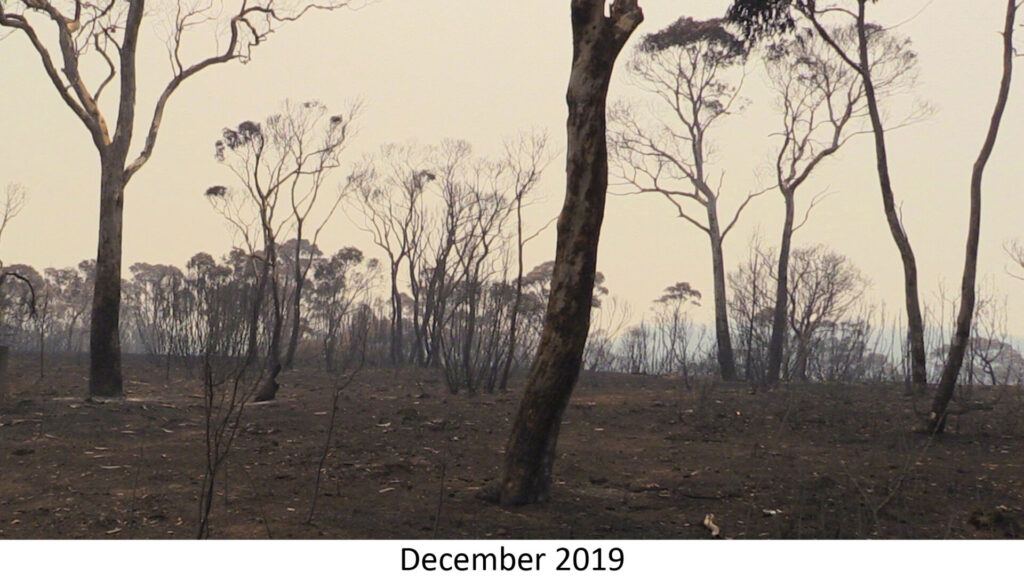
I saw the bees again in 2017 and 2018, but five days before I was due to check them in 2019, the Gospers Mountain fire swept through the area. When I arrived the air was still full of smoke and the sky was yellow. Had there been enough time for the bees to provision nests so that at least some might survive underground to emerge next year? Even if they do, will there be any Goodenia flowering by next December? Did the bees inhabit a much larger area than the one I was aware of and might there have been refugia in that area? When I visited in May there were a considerable number of small plants that I believe are Goodenia but will they flower in time? It will be an anxious six months until December.

References
1. Sam Droege and Laurence Packer, 2015. Bees: An Up-Close Look at Pollinators Around the World, Voyageur Press, Minneapolis.
2. James Dorey, 2018. Bees of Australia. A Photographic Exploration, CSIRO Publishing, Clayton South.
3. Michael Batley, 2019. Australian native bees foraging from Persoonia oblongata (Proteaceae). https://doi.org/10.6084/m9.figshare.7886342.
4. M.P. Black and S.D. Mooney, 2007. The Response of Aboriginal Burning Practices to Population Levels and El Niño-Southern Oscillation Events during the mid- to late-Holocene: a case study from the Sydney Basin using charcoal and pollen analysis. Australian Geographer 38: 37–52.
5. Andreas Müller, 1996. Convergent evolution of morphological specializations in Central European bee and honey wasp species as an adaptation to the uptake of pollen from nototribic flowers (Hymenoptera, Apoidea and Masaridae). Biological Journal of the Linnean Society 57: 235-252.
